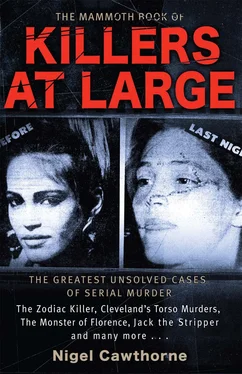In November 2006, the death of Chris Jenkins was reclassified as a homicide. But police in La Crosse dismissed any connection with the drownings there and continued to consider the Wisconsin deaths as accidents.
Brown’s suspect came to her attention after he walked into the police station in St Charles, Missouri, in the late 1990s and announced that he was going to be the next Jeffrey Dahmer. Of course, neither the cops or the FBI believed him, on the grounds at if somebody says they are going to be a serial killer, they are not.
“But it’s not true,” says Brown. “We have a history of exactly that sort of thing, where they do claim it and they are it. They’re trying to practice the concept… people say, ‘I want to be something, so let me go out and say (I am) something, and then after a while I get comfortable with the concept, then I can be it.’”
The man was so persistent that the police even got a restraining order to stop him harassing them. However, one St Charles’ detective did take the man’s claims seriously, particularly when he revealed his obsession with a sexual fantasy of forcing young boy-next-door types underwater and watching them panic and struggle until they drowned. It was then he contacted Brown.
The private eye Chuck Loesch also came across the unidentified man when he was working on the Jenkins case. He lived in Minneapolis at the time of Jenkins’ death, just a few blocks from where he disappeared. Brown says that the man has also spent time in Wisconsin.
The man worked in a funeral parlour—the perfect job for a man fascinated with death. At night he was a part-time male prostitute and was a regular on a website called manunderwater.com for gay men who have a fetish about having sex underwater. The St Charles’ cop asked Brown to see if she could contact the man via the website.
Posing as a 15-year-old boy who had seen his own brother die in a back yard pool years before, Brown role-played with the man via the website’s message boards. She quickly noticed a sadistic bent to the man’s fantasy.
“Some people will present online as one who will share going under water, ‘You drown me then I’ll drown you’ that type of thing,” Brown says. “He’s not like that at all. He doesn’t like being drowned. He just lies about that so he’s not really sharing with you. Once you get to the fantasy with him, he wants to do all the drowning. I mean he’ll play at it one time or so to pretend that you get your turn, but it isn’t that way… It is more about ‘I’m holding you under the water. You’re struggling. You’re struggling. I watch the bubbles come up…’ That’s his whole thing. To watch you drown, to watch your eyes when you’re drowning.”
His emails were disturbing and graphic.
“He would take me under water in various forms of nudity or non-nudity, in different water settings and he would watch me struggle and die. That’s when he would have an orgasm,” Brown recalls.
The man was also cold and calculating, and Brown believes that he confines his activities to Minnesota and Wisconsin as they do not have the death penalty.
“He said he’d never kill in Missouri,” Brown recalled, “because it’s a death-penalty state.”
Meanwhile, the suspect was up to no good in the real world. He made sexual advances towards the teenage son of the owner of the funeral home and, when the father confronted him, he threatened to murder the funeral director’s entire family. When a detective interviewed him, he concluded: “The defendant is a danger to the community… because he goes for white males between 16 and 25… spoke of bondage and putting Saran Wrap over a victim’s face… and has serial-killer tendencies.”
The police then issued a warrant, but when they tried to arrest the man he drove into their squad car and led them on an hour-long car chase. He was jailed for seven months for resisting arrest. The problem was that he was in jail at the time of Jared Dion’s death. Nevertheless Brown believes that he was involved in the four earlier deaths, or that someone with a similar tendency is out there at work.
“There are more serial killers out there than we know about,” Brown says. The La Crosse fatalities are not necessarily all the victims of the same killer. “It could be one guy who maybe killed two of them.”
The detective in St Charles agrees and would like a chance to investigate.
“I think if I had all those cases, he’d be a great lead to eliminate,” he said.
When Stuff magazine told the police in La Crosse police of Brown’s suspect, Captain Mitch Brohmer said that he knew nothing about him. Caroline Kelly, a detective with the Wisconsin Division of Criminal Investigation, admitted that the state police, as well as the local department, had not heard of him.
A former FBI profiler told Stuff that, at 40 years old, Brown’s suspect “has probably done more than just watch. If I had to vote, I’m voting killer.”
While Brown concedes that the man from St Charles may not be the killer in the La Crosse drownings, his existence demonstrates that such a killer may exist.
Los Angeles’ South Side Slayer
Homicide Detective Jeffrey Steinhoff was moved by the death of Princess Berthomieux. On 9 March 2002, her naked body was found dumped in bushes in an alley in the 8100 block of South Van Ness Avenue in Inglewood. She had been strangled. In her short life the runaway from Hawthorne had been in and out of foster homes. The 14-year-old was working as a prostitute when she was killed. There were no further clues to her murderer and she seemed destined to be just one of the dozens of young women in her profession who died at an unknown hand in that area of Los Angeles.
For over two years the case remained cold. But in December 2004, the sheriff’s crime lab linked traces of the DNA found on her body to those taken from the bodies of two other slain women. The first was 26-year-old Mary Lowe who was found on 1 November 1987 in an alley in the 8900 block of South Hobart Boulevard. Last seen at a Halloween party at a club the night before, she had been shot in the chest. In 1979, she had been arrested for prostitution though, at the time of her death, she was working as a receptionist and was living at home with her parents. The second was 35-year-old Valerie McCorvey. Like Princess Berthomieux, she had been strangled. Her body was found on 11 July 2003, dumped near the corner of 108th Street and Denver Avenue.
Valerie McCorvey had dropped out of high school and by her late teens she had a drug habit. She went into rehab and at one time she had a job helping other addicts kick the habit. But the lure of drugs was too powerful, even though she had strong family ties to her father, who had divorced from her mother, and her aunt Mary Taylor. Four months before she died, Valerie left a message on her aunt’s answering machine, saying she was okay. She was found just one block away from her regular hang-out on Figueroa Street. She had been sexually assaulted, though she was still wearing her familiar brown pants and blue leotard.
Initially the police thought an ex-boyfriend was responsible as he was less than forthcoming when they interviewed him. But then the DNA evidence connected her to the murderer of Princess Berthomieux and Mary Lowe.
The following year, another match was made to DNA found on the body of an earlier victim. This was 25-year-old Bernita Sparks, whose body was found on 16 April 1987, covered with garbage, inside a dustbin in an alley in the 9400 block of South Western Avenue. The night before, she had told her mother that she was going out to buy a packet of cigarettes. She was found fully clothed and had no arrests for prostitution. There was evidence that she had been sexually assaulted. She had also suffered blunt-force trauma to the head, been strangled and shot in the chest. The bullet came from the same .25-calibre handgun that had shot Mary Lowe. Ballistics linked the bullets with six other handgun killings in the 1980s.
Читать дальше











